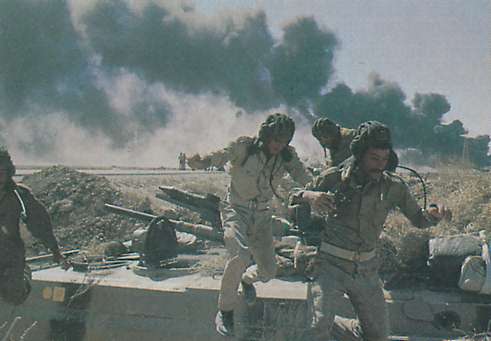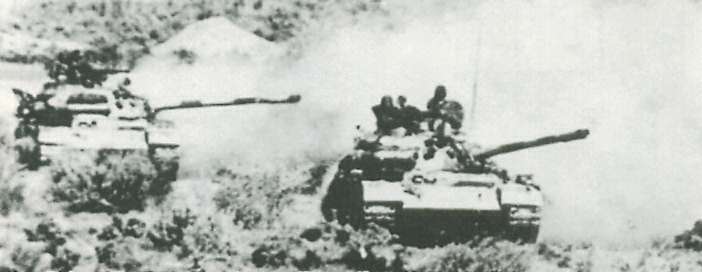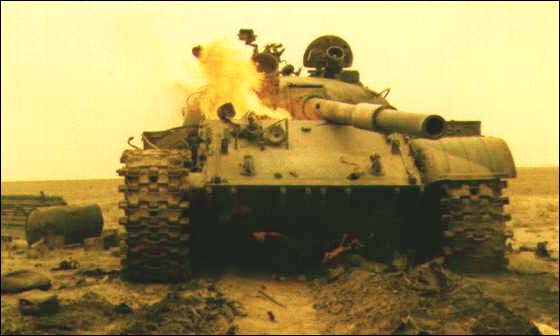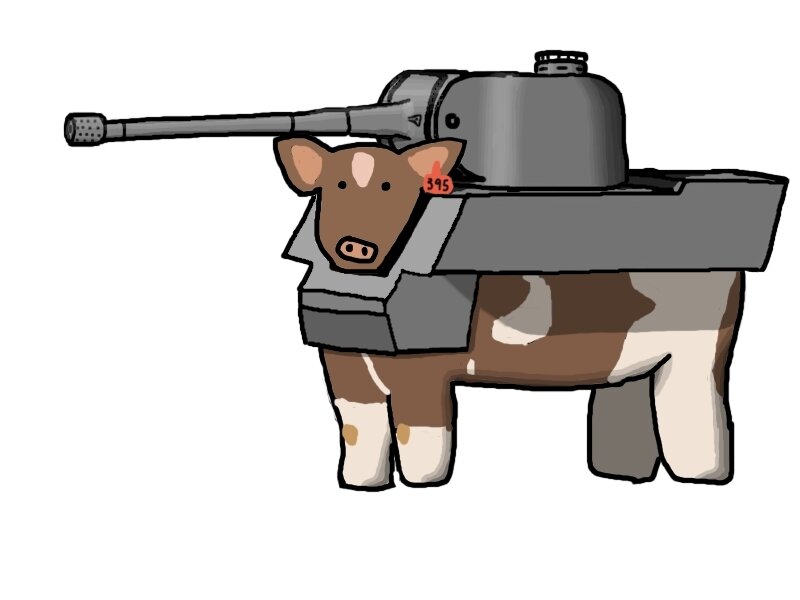Design started in the early 1950's on the Medium Gun tank No 2, renamed in 1962 to the FV4201. The two main requirements were for survivability and firepower. These requirements were due entirely to the expected threat of the Warsaw Pact forces.
In line with with NATO it was decided to fit multi-fuel engines to all new tanks. Everyone else quickly realised this was impractical, however, despite reservations the Chieftain was fielded with such an engine. It is safe to say that the engine was the thing that broke the tank.
The L60 multi-fuel engine was based on parts from a World War Two era Junkers Jumo engine, the same type as those fitted to the various German bombers! It was also built by a company that had a less than stellar reputation in the motoring industry. The engine performance was so poor that when in 1960 automotive trials were carried out, the tank actually failed to finish.
 |
| Conqueror, Centurion and Chieftain м»Ём»Өлҹ¬, м„јмё„лҰ¬мҳЁ, м№ҳн”„нӢҙ |
The armour protection to the front of the tank was provided by cast armour inspired by an IS2 the British had found under a collapsed block of flats in Berlin in 1945. The casting of the turret was so thick that each one had to cool for one year.
In 1962 two tanks were given to the British army for testing in the German winter. At first the crews loved the ability for the tracks to grip the ground, and the handling was deemed to be excellent. Then the crews realised the tank lacked a heater.
The lack of a heater wasn't as much of an issue in Iran. By the time of the 1979 revolution the Iranian army had brought about 700 Chieftains. At the end of 1980 when the Iran-Iraq war broke out, those Chieftains were still crewed by experienced well trained soldiers. The High Command of the Iranian forces wasn't of such high quality. In the Chieftains first combat deployment it began to show its flaws, these were exacerbated by the poor Iranian command.
In January 1981, after the Iraqi offensive had run out of thrust the Iranians launched a counterattack at a place called Susangerd. The Iranians brought about 400 Chieftains to bear on a slightly smaller Iraqi force. The Iranians lacked reconnaissance and artillery support.
Before the battle could be joined Iranian engineers began to construct bridges over the Karkheh River. Without screening reconnaissance forces the Iraqi's could calmly watch and report. Realising that a major offensive was planned the Iraqi force fell back two kilometres and took up defensive positions, also digging in on the flanks to create a perfect kill zone.
The area itself was the flood plain for the river, and was extremely boggy and wet. Only two paved roads ran across the area. The lead Iranian Brigade attacked along these roads in column, with no scouts to screen them.
When the Iraqi's opened fire from their hull down positions they had perfect flank shots negating the huge advantage of the Chieftains frontal armour. Equally when the Chieftains tried to manoeuvre they bogged down and became immobilised with frightening ease due to the poor power output and unreliability of the engine. The entire lead brigade was wiped out.
 |
| Frontal penetrating hits on Iranian Chieftains м „л©ҙмқ„ кҙҖнҶөлӢ№н•ң мқҙлһҖкө°мқҳ м№ҳн”„нӢҙ |
It was all for nought as the Iranian Chieftains took too much of a beating and they had to fall back. After the battle one hundred Iranian tanks had been destroyed and a similar number were captured. The Iraqi's had lost about fifty tanks and fifty more smaller armoured vehicles.
This costly failure did combat test one part of the Chieftain that passed with flying colours, Crew survivability. All the bag charges in the Chieftain were contained in a special storage container filled with a Glycol and water mixture. This often managed to retard the rate at which the bag charges burned when a tank was penetrated. When a container was pierced there would be a white smoke and a loud hissing noise giving warning that a fire had started. Although eventually the fire would spread this would often take several minutes, more than long enough to evacuate wounded crew members. In comparison a Soviet tank on the Iraqi side would often be torn apart immediately by its ammunition exploding if it was penetrated.
 |
| Iraqi's bailing out of a BMP1 мқҙлқјнҒ¬кө°мқҙ BMP1м—җм„ң нғҲм¶ңн•ҳкі мһҲлӢӨ |
Part two will be next week.
Edit 10/2/14:
Made a mistake with the dates, and I, rightly, got called up on it. The error is fixed now.
Chief of Battle: Part two
м „мһҘмқҳ м§Җл°°мһҗ м№ҳн”„нӢҙ: 2л¶Җ
Part one can be found here
1л¶ҖлҠ” м—¬кё°м—җм„ң ліҙм„ёмҡ§
Late at night on August the first 1990, Kuwaiti Intelligence learned of the impending Iraqi invasion. They immediately flashed the warning up through the chain of command. The Kuwaiti 35th Brigade hurriedly started to mobilise its Chieftain tanks. They were hampered by having some squadrons detached to guard duties elsewhere, and numerous soldiers away on leave.
1990л…„ 8мӣ” 1мқјмқҳ лҠҰмқҖ л°Ө, мҝ мӣЁмқҙнҠёмқҳ м •ліҙл¶ҖлҠ” мқҙлқјнҒ¬мқҳ м№Ёкіөмқҙ мһ„л°•н–ҲмқҢмқ„ м•ҢкІҢ лҗ©лӢҲлӢӨ. к·ёл“ӨмқҖ м§Җнңҳ кі„нҶөмқ„ л”°лқј кІҪліҙлҘј мҡёл ёмҠөлӢҲлӢӨ. мҝ мӣЁмқҙнҠё м ң 35 м—¬лӢЁмқҖ ліҙмң н•ҳкі мһҲлҚҳ м№ҳн”„нӢҙ м „м°ЁлҘј нҷ©кёүнһҲ м „нҲ¬л°°м№ҳн•ҳкё° мӢңмһ‘н–ҲмҠөлӢҲлӢӨ. лӢӨмҲҳмқҳ лі‘л Ҙмқҙ мҷём¶ң мӨ‘мқҙм—Ҳкі мқјл¶Җ мҶҢлҢҖлҠ” лӢӨлҘё кіім—җм„ң ліҙмҙҲ к·јл¬ҙлҘј м„ңкі мһҲм—Ҳкё° л•Ңл¬ём—җ мӨҖ비м—җ л°©н•ҙк°Җ лҗҳм—ҲмҠөлӢҲлӢӨ.
As the unit began phoning around trying to find soldiers, one of the Brigade officers began combing through personnel files of soldiers on base. If they'd had any armour training, no matter how long ago, they were assigned to composite crews.л¶ҖлҢҖмӣҗл“Өмқҙ лі‘мӮ¬л“Өмқ„ м°ҫм•„лӮҳм„ лҸҷм•Ҳ м—°лҢҖмқҳ н•ң мһҘкөҗк°Җ кё°м§Җмқҳ лі‘мӮ¬л“Өмқҳ к°ңмқё кё°лЎқ нҢҢмқјмқ„ мІ м ҖнһҲ л’Өм ёліҙкё° мӢңмһ‘н–ҲмҠөлӢҲлӢӨ. л§Ңм•Ҫ кё°к°‘ нӣҲл Ёмқ„ л°ӣмқҖ м Ғмқҙ мһҲлӢӨл©ҙ к·ёкІҢ м–јл§ҲлӮҳ мҳӨлһҳлҗҳм—ҲлҚҳк°„м—җ мғҒкҙҖ м—Ҷмқҙ л§Ҳкө¬ л°°м№ҳн•ҙлІ„л ёмҠөлӢҲлӢӨ.
Meanwhile other troops started to load ammunition into the tanks. Unfortunately this wasn't complete by the time the unit moved out at 0600. In the previous 8 hours the 35th Brigade had managed to find 36 full crews, and partially load their tanks with ammunition. There hadn't been time to boresight (zero) the guns, and the tanks were carrying insufficient supplies of water. The number of tanks was further reduced when one tank broke down on the very short march north.к·ё лҸҷм•Ҳ лӢӨлҘё л¶ҖлҢҖлҠ” м „м°Ём—җ нғ„м•Ҫмқ„ ліҙкёүн•ҳкё° мӢңмһ‘н–ҲмҠөлӢҲлӢӨ. л¶Ҳн–үн•ҳкІҢлҸ„ мқҙлҠ” 0600мӢңм—җ л¶ҖлҢҖк°Җ лӮҳк°Җкё° м „к№Ңм§Җ мҷ„лЈҢлҗҳм§Җ лӘ»н–ҲмҠөлӢҲлӢӨ. 8мӢңк°„ лҸҷм•Ҳ м ң 35 м—¬лӢЁмқҖ 36нҢҖмқҳ мҠ№л¬ҙмӣҗкіј нғ„м•Ҫмқҙ мқјл¶Җл§Ң м Ғмһ¬лҗң м „м°ЁлҘј мӨҖл№„н• мҲҳ мһҲм—ҲмҠөлӢҲлӢӨ. нҸ¬мқҳ мЎ°мӨҖмқ„ м •л ¬н• мӢңк°„лҸ„ м—Ҷм—Ҳкі , м „м°Ём—җ 충분н•ң м–‘мқҳ л¬јмқ„ ліҙкёүн•ҳм§ҖлҸ„ лӘ»н–ҲмҠөлӢҲлӢӨ. м „м°Ё н•ң лҢҖк°Җ л¶ҒмӘҪмңјлЎң н–үкө°мқ„ мӢңмһ‘н•ңм§Җ м–јл§Ҳ м•Ҳлҗҳм–ҙ кі мһҘлӮҳлІ„лҰ¬мһҗ м „м°Ёмқҳ мҲҳлҠ” лҚ”мҡұ мӨ„м–ҙлІ„л ёмҠөлӢҲлӢӨ.
The 35th Brigade deployed two battalions that day. The 7th Battalion had 25 tanks, in three understrength companies while the 8th Battalion, was just a single company of ten tanks.
м ң 35 м—¬лӢЁмқҖ к·ё лӮ 2к°ң лҢҖлҢҖлҘј л°°м№ҳн–ҲмҠөлӢҲлӢӨ. м ң 7 лҢҖлҢҖлҠ” м•Ҫнҷ”лҗң 3к°ңмқҳ мӨ‘лҢҖм—җ 25лҢҖмқҳ м „м°ЁлҘј ліҙмң н•ҳкі мһҲм—Ҳкі м ң 8 лҢҖлҢҖлҠ” лӢЁ н•ң к°ңмқҳ мӨ‘лҢҖк°Җ 10лҢҖмқҳ м „м°ЁлҘј ліҙмң н•ҳкі мһҲмқ„ лҝҗмқҙм—ҲмҠөлӢҲлӢӨ.
The 7th Battalion who were in the lead deployed in hull down positions, in a line, near a graveyard between the town of Al Jahra and Mutlaa ridge. A six lane highway ran diagonally down from the ridge to Al Jahra, and then linked to a ring road. There was a police station next to the road on the ridge, and the 7th Brigade sent a reconnaissance vehicle there. It reported a column of Iraqi's advancing down the road, this turned out to be the Republican Guards Hammurabi Division. м ң 7 лҢҖлҢҖлҠ” Al Jahra л§Ҳмқ„кіј Mutlaa мӮ°л“ұм„ұмқҙ мӮ¬мқҙмқҳ л¬ҳм§Җм—җ мқјл ¬лЎң н—җлӢӨмҡҙ мң„м№ҳлҘј мһЎлҸ„лЎқ мҡ°м„ л°°м№ҳлҗҳм—ҲмҠөлӢҲлӢӨ. 6лІҲ кі мҶҚлҸ„лЎңк°Җ мӮ°м—җм„ң Al Jahraк№Ңм§Җ мӮ¬м„ мңјлЎң м§ҖлӮҳк°Җл©° мҷёкіҪ мҲңнҷҳлҸ„лЎңмҷҖ м—°кІ°лҗҳлҸ„лЎқ лҗҳм–ҙмһҲм—ҲмҠөлӢҲлӢӨ. лҠҘм„ мң„ лҸ„лЎң мҳҶм—җлҠ” кІҪм°°м„ңк°Җ н•ҳлӮҳ мһҲм—Ҳкі , м ң 7 лҢҖлҢҖлҠ” м—¬кё°м—җ м •м°° м°Ёлҹүмқ„ ліҙлғҲмҠөлӢҲлӢӨ. м •м°°м°ЁлҹүмқҖ мқҙлқјнҒ¬кө°мқҙ кёёмқ„ л”°лқј мӨ„м§Җм–ҙ 진кө°н•ҳкі мһҲлӢӨкі ліҙкі н–Ҳмңјл©°, мқҙлҠ” кіөнҷ”көӯ мҲҳ비лҢҖмқҳ н•Ёл¬ҙлқјл№„ мӮ¬лӢЁмңјлЎң л°қнҳҖмЎҢмҠөлӢҲлӢӨ.
As the Iraqi's reached the ring road at 0645, the 7th Battalion opened fire. For the Chieftains with their fearsome firepower the range the Kuwaitis were firing at was practically point blank (around 1500 metres). Here at last was the tank battle the Chieftain had been designed for, defending a line against a larger force of Soviet armour.мқҙлқјнҒ¬кө°мқҙ мҲңнҷҳлҸ„лЎңм—җ 0645мӢңм—җ лҸ„лӢ¬н•ҳмһҗ м ң 7 лҢҖлҢҖлҠ” мӮ¬кІ©мқ„ к°ңмӢңн–ҲмҠөлӢҲлӢӨ. м№ҳн”„нӢҙмқҳ л¬ҙмӢңл¬ҙмӢңн•ң нҷ”л ҘмқҖ мҝ мӣЁмқҙнҠё л¶ҖлҢҖмӣҗл“Өмқҳ көҗм „ кұ°лҰ¬лҘј (лҢҖлһө 1500лҜён„°) мӢӨм§Ҳм ҒмңјлЎң мҳҒкұ°лҰ¬ мӮ¬кІ©мқ„ н•ҳлҠ” кІғмқҙлӮҳ л§Ҳм°¬к°Җм§Җмқё м…Ҳмқҙ лҗҳлҸ„лЎқ л§Ңл“Өм–ҙмЈјм—ҲмҠөлӢҲлӢӨ. л°”лЎң мқҙ м „м°Ём „мқҙ м№ҳн”„нӢҙмқҳ м„Өкі„ лӘ©м Ғмқҙм—ҲлҚҳ ліҙлӢӨ лҢҖк·ңлӘЁмқё мҶҢл Ё кё°к°‘л¶ҖлҢҖм—җ л§һм„ң м „м„ мқ„ м§ҖмјңлӮҙлҠ” м—ӯн• мқ„ мҲҳн–үн•ҳлҠ” кІғмқҙм—ҲмЈ .
The pounding the Iraqi's were taking suddenly let up. Lieutenant-Colonel Al Wazan, the commander of 7th Brigade had received orders to cease fire and return to base! For a few moments the Iraqi's could collect their battered wits, then LTC Al Wazan used his initiative and ordered his battalion to open fire again.мқҙлқјнҒ¬кө°мқ„ н–Ҙн•ң мӮ¬кІ©мқҙ к°‘мһҗкё° м•Ҫн•ҙмЎҢмҠөлӢҲлӢӨ. 7лҢҖлҢҖмқҳ м§ҖнңҳкҙҖмқҙм—ҲлҚҳ Al Wazan мӨ‘л №мқҙ көҗм „мқ„ л©Ҳм¶”кі кё°м§ҖлЎң ліөк·Җн•ҳлқјлҠ” лӘ…л №мқ„ л°ӣмқҖкІҒлӢҲлӢӨ! мқҙлқјнҒ¬кө°мқҖ мһ мӢңлҸҷм•Ҳ м •мӢ мқ„ м°ЁлҰҙ мӢңк°„мқҙ мһҲм—ҲмҠөлӢҲлӢӨл§Ң Al Wazan мӨ‘л №мқҖ кІ°лӢЁл Ҙмқ„ л°ңнңҳн•ҙ лҢҖлҢҖм—җ лӢӨмӢң мӮ¬кІ© лӘ…л №мқ„ лӮҙл ёмҠөлӢҲлӢӨ.
By now the 8th Battalion had arrived on the battlefield. There was an Infantry unit inside Al Jahra that would be surrounded so the 8th Battalion was ordered to advance and link up with the Infantry. мқҙм ң м „мһҘм—җ м ң 8 лҢҖлҢҖк°Җ лҸ„м°©н–ҲмҠөлӢҲлӢӨ. Al Jahraм—җлҠ” нҸ¬мң„лҗ мң„кё°м—җ мІҳн•ң ліҙлі‘ л¶ҖлҢҖк°Җ мһҲм—Ҳкі , 8лҢҖлҢҖлҠ” ліҙлі‘кіј м ‘мҙүн•ҳкё° мң„н•ҙ 진격н•ҳлҸ„лЎқ лӘ…л №л°ӣм•ҳмҠөлӢҲлӢӨ.
Captain Ali, the commander of the the Battalion moved up to the first obstacle, the six lane ring road around Al Jahra. He quickly realised that any attempt to cross the road, especially the central barrier would result in a massacre of his unit. With that in mind he fell back and emplaced his company to the east of the 7th Battalion on the other side of a road that led to the west from the Ring road. лҢҖлҢҖ м§ҖнңҳкҙҖмқҙм—ҲлҚҳ Ali лҢҖмң„лҠ” мІ« лІҲм§ё мһҘм• л¬јмқё Al Jahraмқҳ мҲңнҷҳ лҸ„лЎңлЎң лҢҖлҢҖлҘј мқҙлҸҷмӢңмј°мҠөлӢҲлӢӨ. к·ёлҠ” кёёмқ„ кұҙл„Ҳл ӨлҠ” н–үмң„, нҠ№нһҲ мӨ‘м•ҷ л°©м–ҙм„ мқ„ кұҙл„Ҳл ӨлҠ” мӢңлҸ„лҠ” к·ёмқҳ л¶ҖлҢҖк°Җ мқјл°©м ҒмңјлЎң лӢ№н•ҳкІҢ л§Ңл“Ө кІғмқҙлқјлҠ” м җмқ„ л№ лҘҙкІҢ к№ЁлӢ¬м•ҳмҠөлӢҲлӢӨ. мқҙлҘј лӘ…мӢ¬н•ҳкі нӣ„нҮҙн•ң нӣ„ к·ёмқҳ лҢҖлҢҖлҘј мҲңнҷҳлҸ„лЎңм—җм„ң м„ңмӘҪмңјлЎң мқҙм–ҙм§ҖлҠ” м ң 7 лҢҖлҢҖмқҳ лҸҷмӘҪ кёё кұҙл„ҲнҺёмңјлЎң л°°м№ҳмӢңмј°мҠөлӢҲлӢӨ.
Almost immediately after taking up positions a car came screeching up behind Cpt Ali's tank. He was happy to see the gunner from his normal crew leap out of the drivers seat. The gunner was the battalions best shot, and had been at home on leave when the news of the Iraqi attack had come in.мһҗлҰ¬лҘј мһЎмһҗл§Ҳмһҗ н•ң лҢҖмқҳ м°Ёлҹүмқҙ Ali лҢҖмң„мқҳ м „м°Ё л’Өм—җ лӮҳнғҖлӮ¬мҠөлӢҲлӢӨ. кё°мҒҳкІҢлҸ„ мҡҙм „м„қм—җм„ң к·ёмқҳ м •к·ң мҠ№л¬ҙмӣҗмқё нҸ¬мҲҳк°Җ лӣ°міҗлӮҳмҳӨлҠ” кІғмқ„ ліј мҲҳ мһҲм—ҲмҠөлӢҲлӢӨ. к·ё нҸ¬мҲҳлҠ” лҢҖлҢҖм—җм„ң к°ҖмһҘ лӣ°м–ҙлӮң мӮ¬мҲҳмҳҖкі мқҙлқјнҒ¬кө°мқҙ міҗл“Өм–ҙмҳЁлӢӨлҠ” лүҙмҠӨк°Җ лӮҳмҳ¬ л•ҢлҠ” нңҙк°ҖлЎң 집м—җ мһҲм—Ҳкұ°л“ мҡ”.
No sooner than the gunner had taken his seat, he spotted and killed an Iraqi command/observation vehicle that was mostly obscured by a bridge. Then an Iraqi platoon of three T-72's wormed its way through Al Jahra and tried to launch a flank attack on the 8th Battalion. The Kuwaiti tanks easily spotted them and destroyed all three.нҸ¬мҲҳк°Җ мһҗлҰ¬лҘј мһЎмһҗл§Ҳмһҗ лӢӨлҰ¬м—җ кұ°мқҳ м—„нҸҗн•ҳкі мһҲм—ҲлҚҳ мқҙлқјнҒ¬кө°мқҳ м§Җнңҳ/кҙҖмёЎ м°Ёлҹүмқ„ л°ңкІ¬н•ҳкі нҢҢкҙҙн–ҲмҠөлӢҲлӢӨ. к·ёлҹ¬мһҗ м„ё лҢҖмқҳ T-72лЎң мқҙлЈЁм–ҙ진 мқҙлқјнҒ¬кө° мҶҢлҢҖк°Җ Al JahraлҘј лҡ«кі лӮҳмҷҖ м ң 8 лҢҖлҢҖмқҳ мёЎл©ҙмқ„ л…ёлҰ¬л Өкі н–ҲмҠөлӢҲлӢӨ. мҝ мӣЁмқҙнҠё м „м°ЁлҢҖлҠ” к·ё м„ё лҢҖлҘј мүҪкІҢ л°ңкІ¬н–Ҳкі лӘЁл‘җ кІ©нҢҢн–ҲмҠөлӢҲлӢӨ.
As the morning wore on the tanks had been engaged for a long time, and now the lack of water began to tell, on both sides. At some of the lulls in the battle soldiers from both sides queued up next to each other to buy water from a local roadside water vendor.н•ңм°ёмқ„ көҗм „н•ҳлҚҳ м „м°Ёл“Ө мң„м—җ м•„м№Ён–ҮмӮҙмқҙ лӮҙлҰ¬м—Ҳкі м–‘мёЎ лӘЁл‘җ мқҙм ң л¬јмқҙ л¶ҖмЎұн•ҳлӢӨлҠ” кІғмқ„ к№ЁлӢ¬м•ҳмҠөлӢҲлӢӨ. м „нҲ¬к°Җ мҶҢк°•мғҒнғңм—җ мқҙлҘҙкІҢлҗҳмһҗ м–‘мёЎмқҳ кө°мқёл“Өмқҙ л…ёліҖ мғқмҲҳ нҢҗл§ӨлҢҖм—җм„ң л¬јмқ„ мӮ¬кё° мң„н•ҙ лӮҳлһҖнһҲ мӨ„мқ„ м„°мҠөлӢҲлӢӨ.
About 1100 hours a new threat began to develop. Along the road leading to the west came a second Iraqi division. This was the Republican Guards Medina Division. A small battery of SPG's had set up there to support the tanks. 1100мӢң кІҪмқҙ лҗҳмһҗ мғҲлЎңмҡҙ мң„нҳ‘мқҙ л– мҳӨлҘҙкё° мӢңмһ‘н–ҲмҠөлӢҲлӢӨ. м„ңмӘҪмңјлЎң мқҙм–ҙ진 лҸ„лЎңм—җм„ң мқҙлқјнҒ¬мқҳ л‘җ лІҲм§ё мӮ¬лӢЁмқҙ лӮҳнғҖлӮңкІҒлӢҲлӢӨ. мқҙл“ӨмқҖ кіөнҷ”көӯ мҲҳ비лҢҖ л©”л””лӮҳ мӮ¬лӢЁмқҙм—ҲмҠөлӢҲлӢӨ. мҶҢк·ңлӘЁ мһҗмЈјнҸ¬ нҸ¬лҢҖк°Җ м „м°Ёл“Өмқ„ м§Җмӣҗн•ҳкё° мң„н•ҙ к·ё мӘҪм—җ м„Өм№ҳлҗҳм–ҙ мһҲм—ҲмҠөлӢҲлӢӨ.
The battery commander upon seeing the tanks approach at first thought they were Saudi re-enforcements so he closed with them. As he got closer he saw the tanks were T-72's. If he ran now after being spotted, the Iraqis would realise they were Kuwaitis and obliterate them.нҸ¬лі‘ м§ҖнңҳкҙҖмқҙ м ‘к·јн•ҳлҠ” м „м°ЁлҘј лҙӨмқ„ л•Ң мІҳмқҢм—җлҠ” мӮ¬мҡ°л”” м§Җмӣҗкө°мқҙлқј мғқк°Ғн•ҙм„ң к·ё мӘҪмңјлЎң м ‘к·јн–ҲмҠөлӢҲлӢӨ. к°Җк№Ңмқҙ лӢӨк°Җк°Җл©ҙм„ң к·ё м „м°Ёл“Өмқҙ T-72лқјлҠ” кІғмқ„ к№ЁлӢ¬м•ҳмҠөлӢҲлӢӨ. л§Ңм•Ҫ к·ёк°Җ л°ңкІ¬лҗң нӣ„м—җ лҸ„л§қміҗлІ„лҰ°лӢӨл©ҙ мқҙлқјнҒ¬кө°мқҖ к·ёк°Җ мҝ мӣЁмқҙнҠёмқҳ л¶ҖлҢҖлқјлҠ” кІғмқ„ к№ЁлӢ«кі мӢёк·ёлҰ¬ л°Җм–ҙлІ„лҰҙкІҒлӢҲлӢӨ.
So he decided to bluff, he walked up to the lead T-72 and spoke to the commander and gathered some intelligence on the Iraqis. When the tanks drove past they were none the wiser.
к·ёлһҳм„ң к·ёлҠ” мҶҚмһ„мҲҳлҘј мҚЁліҙкё°лЎң н–ҲмҠөлӢҲлӢӨ. м„ л‘җмқҳ T-72м—җ м ‘к·јн•ҳм—¬ м „м°ЁмһҘкіј лҢҖнҷ”лҘј лӮҳлҲ„кі мқҙлқјнҒ¬кө°м—җ лҢҖн•ң м •ліҙлҘј мЎ°кёҲ м–»м–ҙлғҲмҠөлӢҲлӢӨ. м „м°ЁлҢҖлҠ” к·ёлҢҖлЎң м§ҖлӮҳк°”кі м•„л¬ҙлҸ„ л¬ҙмҠЁ мқјмқҙ мһҲм—ҲлҚҳ кІғмқём§Җ к№ЁлӢ«м§Җ лӘ»н–ҲмЈ .
With enough warning from the artillery position the 8th Battalion shifted so that it refused its left flank, and could keep the Hammurabi Division to its front and also cover the back of the 7th Battalion. The Medina T-72's stormed down the road towards Al Jahra unaware of exactly what was happening.нҸ¬лі‘лҢҖлЎңл¶Җн„° 충분н•ң кІҪкі лҘј л°ӣмқҖ м ң 8 лҢҖлҢҖлҠ” мўҢмёЎмқҙ л…ём¶ңлҗҳм§Җ м•ҠлҸ„лЎқ н•ҳкі н•Ёл¬ҙлқјл№„ мӮ¬лӢЁмқ„ кі„мҶҚ м „л©ҙм—җ л‘җл©ҙм„ң м ң 7 лҢҖлҢҖмқҳ нӣ„л°©лҸ„ ліҙнҳён•ҳкё° мң„н•ҙ кё°лҸҷн–ҲмҠөлӢҲлӢӨ. л©”л””лӮҳ мӮ¬лӢЁмқҳ T-72л“ӨмқҖ л¬ҙмҠЁ мқјмқҙ мқјм–ҙлӮҳкі мһҲлҠ”м§Җ м •нҷ•нһҲ м•Ңм§Җ лӘ»н•ңмұ„ лҸ„лЎңлҘј л”°лқј Al JahraлЎң л§№л ¬н•ҳкІҢ 진격н•ҳмҳҖмҠөлӢҲлӢӨ.
The Medina Division drove between both Kuwaiti battalions and as it entered the frontal arcs of the 7th Battalion all the defenders opened fire wreaking havoc. As the Medina Division fell back after a very short exchange of fire the artillery battery took them under bombardment.л©”л””лӮҳ мӮ¬лӢЁмқҖ л‘җ мҝ мӣЁмқҙнҠё лҢҖлҢҖ мӮ¬мқҙлЎң м§ҖлӮҳк°Җкі мһҲм—Ҳкі м ң 7 лҢҖлҢҖмқҳ м „л©ҙм—җ л“Өм–ҙм„ңмһҗ лӘЁл“ л°©м–ҙкө°мқҙ л°ңнҸ¬н•ҳм—¬ м Ғмқ„ л°•мӮҙлӮҙкё° мӢңмһ‘н–ҲмҠөлӢҲлӢӨ. л©”л””лӮҳ мӮ¬лӢЁмқҙ м•„мЈј 짧мқҖ көҗм „ нӣ„м—җ нӣ„нҮҙн•ҳкё° мӢңмһ‘н•ҳмһҗ нҸ¬лі‘мқҙ к·ё мң„лЎң нҸ¬кІ©мқ„ мҸҹм•„л¶Җм—ҲмҠөлӢҲлӢӨ.
By early afternoon however, the 35th Brigade was running out of ammunition, the tanks had three rounds left at most and many had less. Equally the lack of water was becoming a concern. The biggest issue was that the Medina Division was forming up for another attack from the rear. With no other choice LTC Al Wazan ordered his brigade to retreat. The brigade crossed the border into Saudi Arabia at 1630. к·ёлҹ¬лӮҳ мқҙлҘё мҳӨнӣ„м—җ м ң 35 м—¬лӢЁмқҖ нғ„м•Ҫмқҙ л–Ём–ҙм ёк°Җкі мһҲм—ҲмҠөлӢҲлӢӨ. м „м°Ёл“ӨмқҖ кё°к»Ҹн•ҙм•ј мөңлҢҖ 3л°ңмқҳ нғ„мқ„ ліҙмң н•ҳкі мһҲм—Ҳмңјл©° лҢҖл¶Җ분мқҖ к·ёкІғліҙлӢӨлҸ„ м Ғм—ҲмҠөлӢҲлӢӨ. л¬јмқҳ л¶ҖмЎұ лҳҗн•ң л¬ём ңк°Җ лҗҳм—ҲмҠөлӢҲлӢӨ. к°ҖмһҘ нҒ° л¬ём ңлҠ” л©”л””лӮҳ мӮ¬лӢЁмқҙ нӣ„л°©м—җм„ң лӢӨмӢң кіөкІ©н•ҳкё° мң„н•ҙ м •л ¬ мӨ‘мқҙм—ҲлӢӨлҠ” м җмһ…лӢҲлӢӨ. м–ҙм©” мҲҳ м—Ҷмқҙ Al Wazan мӨ‘л №мқҖ к·ёмқҳ м—¬лӢЁм—җ нӣ„нҮҙ лӘ…л №мқ„ лӮҙл ёмҠөлӢҲлӢӨ. м—¬лӢЁмқҖ 1630мӢңм—җ мӮ¬мҡ°л””м•„лқјл№„м•„лЎң көӯкІҪмқ„ л„ҳм–ҙк°”мҠөлӢҲлӢӨ.
The Chieftain had proved it was able to do exactly what it was designed to do, hold larger forces of Soviet armour at bay. The 35 Chieftains had held up the lead elements of two divisions for nearly ten hours. As well as the one breakdown the brigade had only lost two tanks in the battle.м№ҳн”„нӢҙмқҖ лҚ” нҒ° к·ңлӘЁмқҳ мҶҢл Ё кё°к°‘л¶ҖлҢҖмқҳ 진격мқ„ л§үлҠ”лӢӨлҠ” м„Өкі„ лӘ©м Ғмқ„ лӢ¬м„ұн• мҲҳ мһҲлӢӨлҠ” м җмқ„ мҰқлӘ…н•ҙлғҲмҠөлӢҲлӢӨ. 35лҢҖмқҳ м№ҳн”„нӢҙмқҖ м„ л‘җ л¶ҖлҢҖмҳҖлҚҳ 2к°ң мӮ¬лӢЁмқ„ кұ°мқҳ 10мӢңк°„ лҸҷм•Ҳ 묶м–ҙл‘җм—ҲмҠөлӢҲлӢӨ. м—¬лӢЁмқҳ мҶҗмӢӨмқҖ кі мһҘлӮң н•ң лҢҖмҷҖ м „нҲ¬ мӨ‘ мҶҗмӢӨн•ң 2лҢҖ лҝҗмқҙм—ҲмҠөлӢҲлӢӨ.
1л¶ҖлҠ” м—¬кё°м—җм„ң ліҙм„ёмҡ§
Late at night on August the first 1990, Kuwaiti Intelligence learned of the impending Iraqi invasion. They immediately flashed the warning up through the chain of command. The Kuwaiti 35th Brigade hurriedly started to mobilise its Chieftain tanks. They were hampered by having some squadrons detached to guard duties elsewhere, and numerous soldiers away on leave.
1990л…„ 8мӣ” 1мқјмқҳ лҠҰмқҖ л°Ө, мҝ мӣЁмқҙнҠёмқҳ м •ліҙл¶ҖлҠ” мқҙлқјнҒ¬мқҳ м№Ёкіөмқҙ мһ„л°•н–ҲмқҢмқ„ м•ҢкІҢ лҗ©лӢҲлӢӨ. к·ёл“ӨмқҖ м§Җнңҳ кі„нҶөмқ„ л”°лқј кІҪліҙлҘј мҡёл ёмҠөлӢҲлӢӨ. мҝ мӣЁмқҙнҠё м ң 35 м—¬лӢЁмқҖ ліҙмң н•ҳкі мһҲлҚҳ м№ҳн”„нӢҙ м „м°ЁлҘј нҷ©кёүнһҲ м „нҲ¬л°°м№ҳн•ҳкё° мӢңмһ‘н–ҲмҠөлӢҲлӢӨ. лӢӨмҲҳмқҳ лі‘л Ҙмқҙ мҷём¶ң мӨ‘мқҙм—Ҳкі мқјл¶Җ мҶҢлҢҖлҠ” лӢӨлҘё кіім—җм„ң ліҙмҙҲ к·јл¬ҙлҘј м„ңкі мһҲм—Ҳкё° л•Ңл¬ём—җ мӨҖ비м—җ л°©н•ҙк°Җ лҗҳм—ҲмҠөлӢҲлӢӨ.
Meanwhile other troops started to load ammunition into the tanks. Unfortunately this wasn't complete by the time the unit moved out at 0600. In the previous 8 hours the 35th Brigade had managed to find 36 full crews, and partially load their tanks with ammunition. There hadn't been time to boresight (zero) the guns, and the tanks were carrying insufficient supplies of water. The number of tanks was further reduced when one tank broke down on the very short march north.
The 35th Brigade deployed two battalions that day. The 7th Battalion had 25 tanks, in three understrength companies while the 8th Battalion, was just a single company of ten tanks.
м ң 35 м—¬лӢЁмқҖ к·ё лӮ 2к°ң лҢҖлҢҖлҘј л°°м№ҳн–ҲмҠөлӢҲлӢӨ. м ң 7 лҢҖлҢҖлҠ” м•Ҫнҷ”лҗң 3к°ңмқҳ мӨ‘лҢҖм—җ 25лҢҖмқҳ м „м°ЁлҘј ліҙмң н•ҳкі мһҲм—Ҳкі м ң 8 лҢҖлҢҖлҠ” лӢЁ н•ң к°ңмқҳ мӨ‘лҢҖк°Җ 10лҢҖмқҳ м „м°ЁлҘј ліҙмң н•ҳкі мһҲмқ„ лҝҗмқҙм—ҲмҠөлӢҲлӢӨ.
The pounding the Iraqi's were taking suddenly let up. Lieutenant-Colonel Al Wazan, the commander of 7th Brigade had received orders to cease fire and return to base! For a few moments the Iraqi's could collect their battered wits, then LTC Al Wazan used his initiative and ordered his battalion to open fire again.
By now the 8th Battalion had arrived on the battlefield. There was an Infantry unit inside Al Jahra that would be surrounded so the 8th Battalion was ordered to advance and link up with the Infantry.
Almost immediately after taking up positions a car came screeching up behind Cpt Ali's tank. He was happy to see the gunner from his normal crew leap out of the drivers seat. The gunner was the battalions best shot, and had been at home on leave when the news of the Iraqi attack had come in.
No sooner than the gunner had taken his seat, he spotted and killed an Iraqi command/observation vehicle that was mostly obscured by a bridge. Then an Iraqi platoon of three T-72's wormed its way through Al Jahra and tried to launch a flank attack on the 8th Battalion. The Kuwaiti tanks easily spotted them and destroyed all three.
The battery commander upon seeing the tanks approach at first thought they were Saudi re-enforcements so he closed with them. As he got closer he saw the tanks were T-72's. If he ran now after being spotted, the Iraqis would realise they were Kuwaitis and obliterate them.
So he decided to bluff, he walked up to the lead T-72 and spoke to the commander and gathered some intelligence on the Iraqis. When the tanks drove past they were none the wiser.
к·ёлһҳм„ң к·ёлҠ” мҶҚмһ„мҲҳлҘј мҚЁліҙкё°лЎң н–ҲмҠөлӢҲлӢӨ. м„ л‘җмқҳ T-72м—җ м ‘к·јн•ҳм—¬ м „м°ЁмһҘкіј лҢҖнҷ”лҘј лӮҳлҲ„кі мқҙлқјнҒ¬кө°м—җ лҢҖн•ң м •ліҙлҘј мЎ°кёҲ м–»м–ҙлғҲмҠөлӢҲлӢӨ. м „м°ЁлҢҖлҠ” к·ёлҢҖлЎң м§ҖлӮҳк°”кі м•„л¬ҙлҸ„ л¬ҙмҠЁ мқјмқҙ мһҲм—ҲлҚҳ кІғмқём§Җ к№ЁлӢ«м§Җ лӘ»н–ҲмЈ .
With enough warning from the artillery position the 8th Battalion shifted so that it refused its left flank, and could keep the Hammurabi Division to its front and also cover the back of the 7th Battalion. The Medina T-72's stormed down the road towards Al Jahra unaware of exactly what was happening.
By early afternoon however, the 35th Brigade was running out of ammunition, the tanks had three rounds left at most and many had less. Equally the lack of water was becoming a concern. The biggest issue was that the Medina Division was forming up for another attack from the rear. With no other choice LTC Al Wazan ordered his brigade to retreat. The brigade crossed the border into Saudi Arabia at 1630.





















 Skirmish
Skirmish 